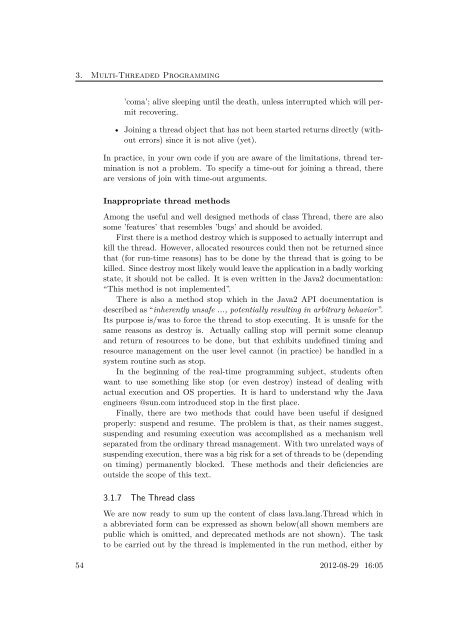JAVA-BASED REAL-TIME PROGRAMMING
JAVA-BASED REAL-TIME PROGRAMMING
JAVA-BASED REAL-TIME PROGRAMMING
Create successful ePaper yourself
Turn your PDF publications into a flip-book with our unique Google optimized e-Paper software.
3. Multi-Threaded Programming<br />
’coma’; alive sleeping until the death, unless interrupted which will permit<br />
recovering.<br />
• Joining a thread object that has not been started returns directly (without<br />
errors) since it is not alive (yet).<br />
In practice, in your own code if you are aware of the limitations, thread termination<br />
is not a problem. To specify a time-out for joining a thread, there<br />
are versions of join with time-out arguments.<br />
Inappropriate thread methods<br />
Among the useful and well designed methods of class Thread, there are also<br />
some ’features’ that resembles ’bugs’ and should be avoided.<br />
First there is a method destroy which is supposed to actually interrupt and<br />
kill the thread. However, allocated resources could then not be returned since<br />
that (for run-time reasons) has to be done by the thread that is going to be<br />
killed. Since destroy most likely would leave the application in a badly working<br />
state, it should not be called. It is even written in the Java2 documentation:<br />
“This method is not implemented”.<br />
There is also a method stop which in the Java2 API documentation is<br />
described as “inherently unsafe ..., potentially resulting in arbitrary behavior”.<br />
Its purpose is/was to force the thread to stop executing. It is unsafe for the<br />
same reasons as destroy is. Actually calling stop will permit some cleanup<br />
and return of resources to be done, but that exhibits undefined timing and<br />
resource management on the user level cannot (in practice) be handled in a<br />
system routine such as stop.<br />
In the beginning of the real-time programming subject, students often<br />
want to use something like stop (or even destroy) instead of dealing with<br />
actual execution and OS properties. It is hard to understand why the Java<br />
engineers @sun.com introduced stop in the first place.<br />
Finally, there are two methods that could have been useful if designed<br />
properly: suspend and resume. The problem is that, as their names suggest,<br />
suspending and resuming execution was accomplished as a mechanism well<br />
separated from the ordinary thread management. With two unrelated ways of<br />
suspending execution, there was a big risk for a set of threads to be (depending<br />
on timing) permanently blocked. These methods and their deficiencies are<br />
outside the scope of this text.<br />
3.1.7 The Thread class<br />
We are now ready to sum up the content of class lava.lang.Thread which in<br />
a abbreviated form can be expressed as shown below(all shown members are<br />
public which is omitted, and deprecated methods are not shown). The task<br />
to be carried out by the thread is implemented in the run method, either by<br />
54 2012-08-29 16:05

















